Bochao Zou
Boosting Micro-Expression Analysis via Prior-Guided Video-Level Regression
Aug 26, 2025Abstract:Micro-expressions (MEs) are involuntary, low-intensity, and short-duration facial expressions that often reveal an individual's genuine thoughts and emotions. Most existing ME analysis methods rely on window-level classification with fixed window sizes and hard decisions, which limits their ability to capture the complex temporal dynamics of MEs. Although recent approaches have adopted video-level regression frameworks to address some of these challenges, interval decoding still depends on manually predefined, window-based methods, leaving the issue only partially mitigated. In this paper, we propose a prior-guided video-level regression method for ME analysis. We introduce a scalable interval selection strategy that comprehensively considers the temporal evolution, duration, and class distribution characteristics of MEs, enabling precise spotting of the onset, apex, and offset phases. In addition, we introduce a synergistic optimization framework, in which the spotting and recognition tasks share parameters except for the classification heads. This fully exploits complementary information, makes more efficient use of limited data, and enhances the model's capability. Extensive experiments on multiple benchmark datasets demonstrate the state-of-the-art performance of our method, with an STRS of 0.0562 on CAS(ME)$^3$ and 0.2000 on SAMMLV. The code is available at https://github.com/zizheng-guo/BoostingVRME.
ME-TST+: Micro-expression Analysis via Temporal State Transition with ROI Relationship Awareness
Aug 11, 2025Abstract:Micro-expressions (MEs) are regarded as important indicators of an individual's intrinsic emotions, preferences, and tendencies. ME analysis requires spotting of ME intervals within long video sequences and recognition of their corresponding emotional categories. Previous deep learning approaches commonly employ sliding-window classification networks. However, the use of fixed window lengths and hard classification presents notable limitations in practice. Furthermore, these methods typically treat ME spotting and recognition as two separate tasks, overlooking the essential relationship between them. To address these challenges, this paper proposes two state space model-based architectures, namely ME-TST and ME-TST+, which utilize temporal state transition mechanisms to replace conventional window-level classification with video-level regression. This enables a more precise characterization of the temporal dynamics of MEs and supports the modeling of MEs with varying durations. In ME-TST+, we further introduce multi-granularity ROI modeling and the slowfast Mamba framework to alleviate information loss associated with treating ME analysis as a time-series task. Additionally, we propose a synergy strategy for spotting and recognition at both the feature and result levels, leveraging their intrinsic connection to enhance overall analysis performance. Extensive experiments demonstrate that the proposed methods achieve state-of-the-art performance. The codes are available at https://github.com/zizheng-guo/ME-TST.
From Black Boxes to Transparent Minds: Evaluating and Enhancing the Theory of Mind in Multimodal Large Language Models
Jun 17, 2025Abstract:As large language models evolve, there is growing anticipation that they will emulate human-like Theory of Mind (ToM) to assist with routine tasks. However, existing methods for evaluating machine ToM focus primarily on unimodal models and largely treat these models as black boxes, lacking an interpretative exploration of their internal mechanisms. In response, this study adopts an approach based on internal mechanisms to provide an interpretability-driven assessment of ToM in multimodal large language models (MLLMs). Specifically, we first construct a multimodal ToM test dataset, GridToM, which incorporates diverse belief testing tasks and perceptual information from multiple perspectives. Next, our analysis shows that attention heads in multimodal large models can distinguish cognitive information across perspectives, providing evidence of ToM capabilities. Furthermore, we present a lightweight, training-free approach that significantly enhances the model's exhibited ToM by adjusting in the direction of the attention head.
DeCoDe: Defer-and-Complement Decision-Making via Decoupled Concept Bottleneck Models
May 25, 2025Abstract:In human-AI collaboration, a central challenge is deciding whether the AI should handle a task, be deferred to a human expert, or be addressed through collaborative effort. Existing Learning to Defer approaches typically make binary choices between AI and humans, neglecting their complementary strengths. They also lack interpretability, a critical property in high-stakes scenarios where users must understand and, if necessary, correct the model's reasoning. To overcome these limitations, we propose Defer-and-Complement Decision-Making via Decoupled Concept Bottleneck Models (DeCoDe), a concept-driven framework for human-AI collaboration. DeCoDe makes strategy decisions based on human-interpretable concept representations, enhancing transparency throughout the decision process. It supports three flexible modes: autonomous AI prediction, deferral to humans, and human-AI collaborative complementarity, selected via a gating network that takes concept-level inputs and is trained using a novel surrogate loss that balances accuracy and human effort. This approach enables instance-specific, interpretable, and adaptive human-AI collaboration. Experiments on real-world datasets demonstrate that DeCoDe significantly outperforms AI-only, human-only, and traditional deferral baselines, while maintaining strong robustness and interpretability even under noisy expert annotations.
Enhancing LLM Reasoning with Multi-Path Collaborative Reactive and Reflection agents
Jan 03, 2025



Abstract:Agents have demonstrated their potential in scientific reasoning tasks through large language models. However, they often face challenges such as insufficient accuracy and degeneration of thought when handling complex reasoning tasks, which impede their performance. To overcome these issues, we propose the Reactive and Reflection agents with Multi-Path Reasoning (RR-MP) Framework, aimed at enhancing the reasoning capabilities of LLMs. Our approach improves scientific reasoning accuracy by employing a multi-path reasoning mechanism where each path consists of a reactive agent and a reflection agent that collaborate to prevent degeneration of thought inherent in single-agent reliance. Additionally, the RR-MP framework does not require additional training; it utilizes multiple dialogue instances for each reasoning path and a separate summarizer to consolidate insights from all paths. This design integrates diverse perspectives and strengthens reasoning across each path. We conducted zero-shot and few-shot evaluations on tasks involving moral scenarios, college-level physics, and mathematics. Experimental results demonstrate that our method outperforms baseline approaches, highlighting the effectiveness and advantages of the RR-MP framework in managing complex scientific reasoning tasks.
A2RNet: Adversarial Attack Resilient Network for Robust Infrared and Visible Image Fusion
Dec 18, 2024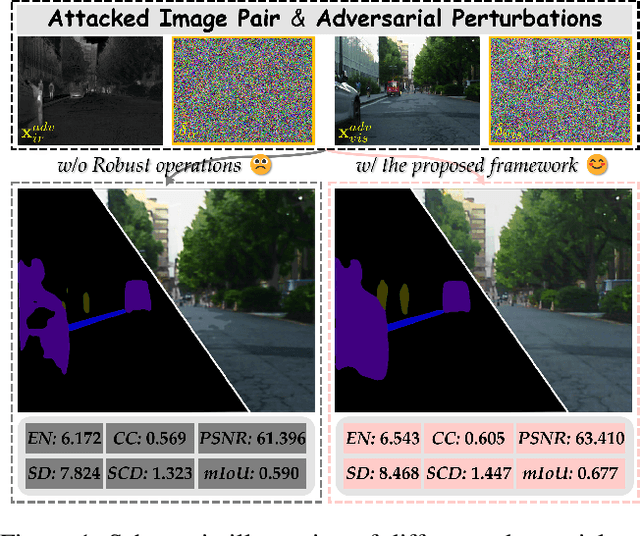


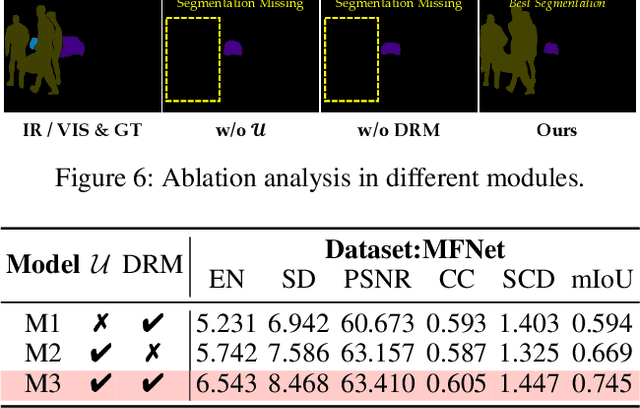
Abstract:Infrared and visible image fusion (IVIF) is a crucial technique for enhancing visual performance by integrating unique information from different modalities into one fused image. Exiting methods pay more attention to conducting fusion with undisturbed data, while overlooking the impact of deliberate interference on the effectiveness of fusion results. To investigate the robustness of fusion models, in this paper, we propose a novel adversarial attack resilient network, called $\textrm{A}^{\textrm{2}}$RNet. Specifically, we develop an adversarial paradigm with an anti-attack loss function to implement adversarial attacks and training. It is constructed based on the intrinsic nature of IVIF and provide a robust foundation for future research advancements. We adopt a Unet as the pipeline with a transformer-based defensive refinement module (DRM) under this paradigm, which guarantees fused image quality in a robust coarse-to-fine manner. Compared to previous works, our method mitigates the adverse effects of adversarial perturbations, consistently maintaining high-fidelity fusion results. Furthermore, the performance of downstream tasks can also be well maintained under adversarial attacks. Code is available at https://github.com/lok-18/A2RNet.
$\textrm{A}^{\textrm{2}}$RNet: Adversarial Attack Resilient Network for Robust Infrared and Visible Image Fusion
Dec 13, 2024



Abstract:Infrared and visible image fusion (IVIF) is a crucial technique for enhancing visual performance by integrating unique information from different modalities into one fused image. Exiting methods pay more attention to conducting fusion with undisturbed data, while overlooking the impact of deliberate interference on the effectiveness of fusion results. To investigate the robustness of fusion models, in this paper, we propose a novel adversarial attack resilient network, called $\textrm{A}^{\textrm{2}}$RNet. Specifically, we develop an adversarial paradigm with an anti-attack loss function to implement adversarial attacks and training. It is constructed based on the intrinsic nature of IVIF and provide a robust foundation for future research advancements. We adopt a Unet as the pipeline with a transformer-based defensive refinement module (DRM) under this paradigm, which guarantees fused image quality in a robust coarse-to-fine manner. Compared to previous works, our method mitigates the adverse effects of adversarial perturbations, consistently maintaining high-fidelity fusion results. Furthermore, the performance of downstream tasks can also be well maintained under adversarial attacks. Code is available at https://github.com/lok-18/A2RNet.
Exploring Information-Theoretic Metrics Associated with Neural Collapse in Supervised Training
Sep 25, 2024



Abstract:In this paper, we utilize information-theoretic metrics like matrix entropy and mutual information to analyze supervised learning. We explore the information content of data representations and classification head weights and their information interplay during supervised training. Experiments show that matrix entropy cannot solely describe the interaction of the information content of data representation and classification head weights but it can effectively reflect the similarity and clustering behavior of the data. Inspired by this, we propose a cross-modal alignment loss to improve the alignment between the representations of the same class from different modalities. Moreover, in order to assess the interaction of the information content of data representation and classification head weights more accurately, we utilize new metrics like matrix mutual information ratio (MIR) and matrix information entropy difference ratio (HDR). Through theory and experiment, we show that HDR and MIR can not only effectively describe the information interplay of supervised training but also improve the performance of supervised and semi-supervised learning.
Synergistic Spotting and Recognition of Micro-Expression via Temporal State Transition
Sep 15, 2024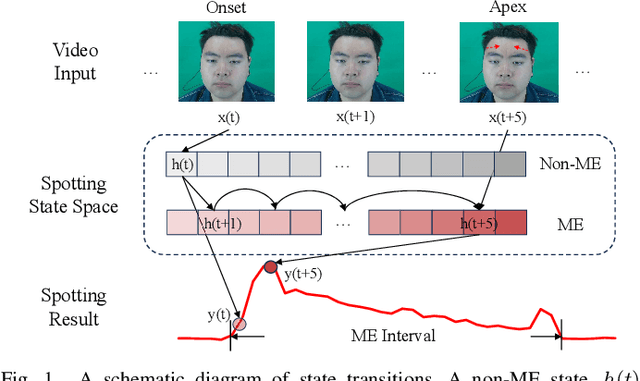
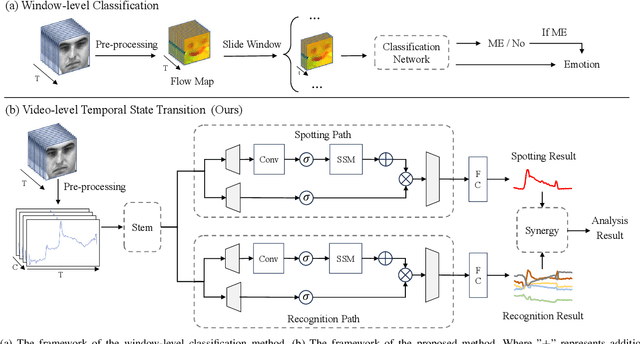
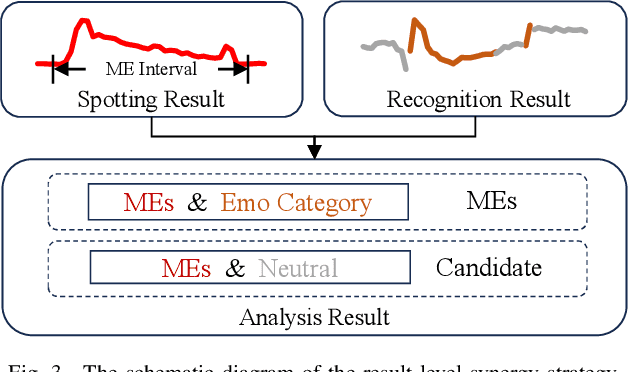
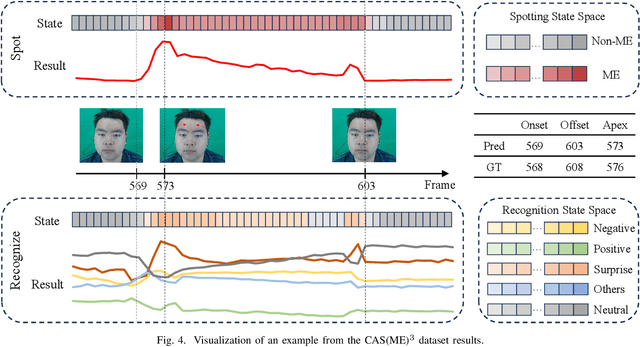
Abstract:Micro-expressions are involuntary facial movements that cannot be consciously controlled, conveying subtle cues with substantial real-world applications. The analysis of micro-expressions generally involves two main tasks: spotting micro-expression intervals in long videos and recognizing the emotions associated with these intervals. Previous deep learning methods have primarily relied on classification networks utilizing sliding windows. However, fixed window sizes and window-level hard classification introduce numerous constraints. Additionally, these methods have not fully exploited the potential of complementary pathways for spotting and recognition. In this paper, we present a novel temporal state transition architecture grounded in the state space model, which replaces conventional window-level classification with video-level regression. Furthermore, by leveraging the inherent connections between spotting and recognition tasks, we propose a synergistic strategy that enhances overall analysis performance. Extensive experiments demonstrate that our method achieves state-of-the-art performance. The codes and pre-trained models are available at https://github.com/zizheng-guo/ME-TST.
Unveiling the Dynamics of Information Interplay in Supervised Learning
Jun 06, 2024Abstract:In this paper, we use matrix information theory as an analytical tool to analyze the dynamics of the information interplay between data representations and classification head vectors in the supervised learning process. Specifically, inspired by the theory of Neural Collapse, we introduce matrix mutual information ratio (MIR) and matrix entropy difference ratio (HDR) to assess the interactions of data representation and class classification heads in supervised learning, and we determine the theoretical optimal values for MIR and HDR when Neural Collapse happens. Our experiments show that MIR and HDR can effectively explain many phenomena occurring in neural networks, for example, the standard supervised training dynamics, linear mode connectivity, and the performance of label smoothing and pruning. Additionally, we use MIR and HDR to gain insights into the dynamics of grokking, which is an intriguing phenomenon observed in supervised training, where the model demonstrates generalization capabilities long after it has learned to fit the training data. Furthermore, we introduce MIR and HDR as loss terms in supervised and semi-supervised learning to optimize the information interactions among samples and classification heads. The empirical results provide evidence of the method's effectiveness, demonstrating that the utilization of MIR and HDR not only aids in comprehending the dynamics throughout the training process but can also enhances the training procedure itself.
 Add to Chrome
Add to Chrome Add to Firefox
Add to Firefox Add to Edge
Add to Edge